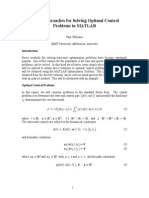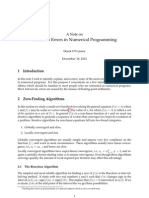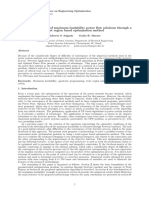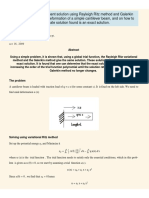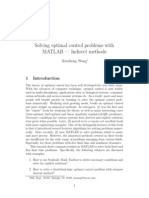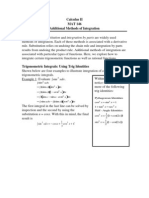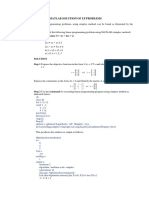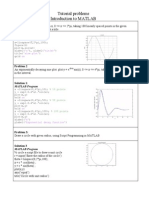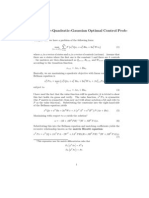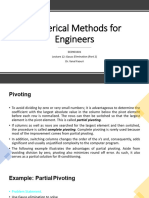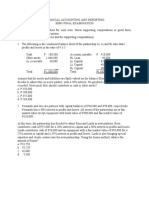Optimal Dispatch of Generation Part I: Unconstrained Parameter Optimization
Optimal Dispatch of Generation Part I: Unconstrained Parameter Optimization
Uploaded by
sweetu_adit_eeCopyright:
Available Formats
Optimal Dispatch of Generation Part I: Unconstrained Parameter Optimization
Optimal Dispatch of Generation Part I: Unconstrained Parameter Optimization
Uploaded by
sweetu_adit_eeOriginal Title
Copyright
Available Formats
Share this document
Did you find this document useful?
Is this content inappropriate?
Copyright:
Available Formats
Optimal Dispatch of Generation Part I: Unconstrained Parameter Optimization
Optimal Dispatch of Generation Part I: Unconstrained Parameter Optimization
Uploaded by
sweetu_adit_eeCopyright:
Available Formats
Chapter 7
Optimal Dispatch of Generation Part I
7.1 Introduction
When generators are interconnected with various loads, the generation capacity is usually
much larger than the loads, hence the allocation of loads on the generators can be varied.
It is important to reduce the cost of electricity as much as possible, hence the "optimal"
division of load (meaning the least expensive) is desired. The most expensive cost of
generation is the fuel cost. Other expenses include labor, repairs and maintenance.
These are "economical" factors. Other factors (not considered in this presentation)
include such factors as security, stability and aesthetics.
7.2 Nonlinear Function Optimization
Unconstrained Parameter Optimization
The necessary condition for the function
( ) ( )
1 2
, , ,
n
f x f x x x K to have a minimum is
obtained by setting the derivatives 0, 1,2, ,
i
f
i n
x
K . Or using the operator,
0 f where
1 2
, , ,
n
f f f
f
x x x
_
,
K is known as the gradient of f . The term
H associated with second derivative:
2
i j
f
H
x x
results in a symmetric matrix called the
Hessian matrix of the function
( )
f x . Suppose
( )
0 f x where
( )
1 2
, , ,
n
x x x x K is a
local extremum. For this to be a minimum, the Hessian matrix should be positive
definite. This can be checked by finding the eigenvalues of the Hessian matrix, all of
which should be positive at x . In the process of doing this, two functions from Matlab
will be very useful, they are shown below. If x Ab , then the solution is found in
Matlab as \ x A b . Also, the eigenvectors of H are found using the Matlab function
eig(H).
Example 7.1
Find the minimum of
( )
2 2 2
1 2 3 1 2 2 3 1 2 3
2 3 8 16 32 110 f x x x x x x x x x x x + + + + + .
Finding the first derivatives and equate to zero results in three linear algebraic equations
thus:
2
1 2
1
1 2 3
2
2 3
3
2 8 0
4 16 0
6 32 0
f
x x
x
f
x x x
x
f
x x
x
+ +
or:
1
2
3
2 1 0 8
1 4 1 16
0 1 6 32
x
x
x
1 1 1
1 1 1
1 1 1
1 1 1
] ] ]
Using Matlab we have:
A=[2 1 0; 1 4 1; 0 1 6];
b=[8;16;32];
x=A\b
eigenvalues=eig(A)
x =
3.0000
2.0000
5.0000
eigenvalues =
1.5505
4.0000
6.4495
Thus the eigenvalues are all positive, thus x=(3, 2, 5) is a minimum (in this case a global
minimum since there is only one extremum).
7.2.1 Constrained Parameter Optimization:
Equality Constraints
Here we minimize
( )
f x subject to the constraints
( )
0, 1,2, ,
i
g x i k K . Such
problems can be solved using Lagrange multipliers
i
thus we let
1
k
i i
i
f g
L . The
necessary conditions for constrained local minima of L are the following:
1
0
0
k
i
i
i i i i
i
i
f g
x x x
g
L
L
Note that the last equation is the same as the original constraints.
Example 7.2
3
Use the Lagrange multiplier method for solving constrained parameter optimizations to
determine the minimum distance from the origin of the xy-plane to a circle described by
( ) ( )
2 2
8 6 25 x y + . The distance to be minimized is given by
( )
2 2
, f x y x y + .
First we use Matlab to show a graphical display of the two curves from which it is clear
that the answer is at (4, 3). Note there is also a maximum at (12, 9).
wt=0:.01:2*pi;
z =8+j*6+ 5*(cos(wt) + j*sin(wt));
x=0:.01:12; y=6/8*x;
plot(real(z),imag(z), x, y), grid
xlabel('x'), ylabel('y')
axis([0 , 14, 0, 14])
0 2 4 6 8 10 12 14
0
2
4
6
8
10
12
14
x
y
Now we want to minimize
( )
, f x y subject to the constraints described by the circle
equation. We first form the Lagrange function thus:
( ) ( )
2 2
2 2
8 6 25 x y x y
1
+ + +
]
L
The necessary conditions for an extremum are found as
4
( ) ( )
( ) ( )
( ) ( )
2 2
2 2 16 0 or 2 1 16
2 2 12 0 2 1 12
8 6 25 0
x x x
x
y y or y
y
x y
+ +
+ +
L
L
L
Dividing the first two equations yields
3
4
y x . Using this in the third equation yields
2
25
25 75 0
16
x x +
Solving the quadratic gives 4 x and 12 x . Thus the extrema are at the points (4, 3)
with 1 , and (12, 9) with 3 . From the figure it is clear that the first point is the
minimum.
In many situations the equations are not only nonlinear but also cannot be solved in an
analytical manner, thus the solution has to be obtained by iteration. The most common
iteration method is the Newton-Raphson method. This is done below for the above
problem. Solve the first two equations for x and y in terms of :
8
1
6
1
x
y
+
Using these values in the third equation yields:
( ) ( ) ( )
( )
2
2
100 200
, 75 0
1
1
f f x y
+ 1
]
+
+
This equation can be solved by iteration as follows using the Newton-Raphson method.
Using the first order term in a Taylor series expansion we have:
( )
( )
( )
( )
( ) ( ) ( ) 1
and
k
k k k k
k
f
df
d
+
_
,
where
( )
( ) k
f is the residual at
( ) k
given by
( )
( )
( ) ( )
( )
,
k k k
f f x y . If this residual is
zero, the solution is exact, otherwise we would like the residual to satisfy a very small
convergence value. The iteration is started with an estimated value of and continued
till a specified accuracy. Once is known, x and y can be computed from the equations
above. One disadvantage to this method is the need to find the derivative of the function
which in this case is found to be:
( )
( ) ( ) ( )
3 2 3
200 200 200
1 1 1
df
d
+ + +
5
Having a value for
(0)
using the above equation we have
(0)
f
,
. Now we can
compute
(0)
x and
(0)
y hence we have a value for use in:
( ) ( ) ( )
2 2
(0)
( 0) (0)
8 6 25 f x y +
and now we can find
( )
( )
( )
0
(0)
0
f
df
d
_
,
. Thus we have a new value for
(1)
. The
process is repeated till the the error in evaluating f is less than some prescribed value.
The following Matlab program will perform the iteration:
clear;
iter = 0; % Iteration counter
Df = 10; % Error in Df is set to a high value
Lambda = 0.4; % Initial estimated value of Lambda
disp([' Iter Df J DLambda Lambda x
y'])
while abs(Df) >= 0.0001 % Test for convergence
iter = iter + 1; % No. of iterations
x = 8*Lambda/(Lambda + 1);
y = 6*Lambda/(Lambda + 1);
Df = (x- 8)^2 + (y - 6)^2 - 25; % Residual
J = 200*Lambda/(Lambda + 1)^3 - 200/(Lambda + 1)^2; % Derivative
Delambda =-Df/J; % Change in variable
disp([iter, Df, J, Delambda, Lambda, x, y])
Lambda = Lambda + Delambda; % Successive solution
end
Iter Df J DLambda Lambda x y
1.0000 26.0204 -72.8863 0.3570 0.4000 2.2857 1.7143
2.0000 7.3934 -36.8735 0.2005 0.7570 3.4468 2.5851
3.0000 1.0972 -26.6637 0.0411 0.9575 3.9132 2.9349
4.0000 0.0337 -25.0505 0.0013 0.9987 3.9973 2.9980
5.0000 0.0000 -25.0001 0.0000 1.0000 4.0000 3.0000
We repeat the program with an initial value of 2 :
clear;
iter = 0; % Iteration counter
Df = 10; % Error in Df is set to a high value
Lambda = -2; % Initial estimated value of Lambda
disp([' Iter Df J DLambda Lambda x
y'])
while abs(Df) >= 0.0001 % Test for convergence
iter = iter + 1; % No. of iterations
x = 8*Lambda/(Lambda + 1);
y = 6*Lambda/(Lambda + 1);
Df = (x- 8)^2 + (y - 6)^2 - 25; % Residual
J = 200*Lambda/(Lambda + 1)^3 - 200/(Lambda + 1)^2; % Derivative
Delambda =-Df/J; % Change in variable
6
disp([iter, Df, J, Delambda, Lambda, x, y])
Lambda = Lambda + Delambda; % Successive solution
end
Iter Df J DLambda Lambda x y
1.0000 75.0000 200.0000 -0.3750 -2.0000 16.0000 12.0000
2.0000 27.8926 76.9346 -0.3625 -2.3750 13.8182 10.3636
3.0000 8.1227 38.1258 -0.2131 -2.7375 12.6042 9.4531
4.0000 1.2823 26.9480 -0.0476 -2.9506 12.1013 9.0760
5.0000 0.0454 25.0682 -0.0018 -2.9982 12.0036 9.0027
6.0000 0.0001 25.0001 -0.0000 -3.0000 12.0000 9.0000
Now the solution converges to the "maximum" distance at (12, 9).
7.2.2 Constraint Parameter Optimization:
Inequality Constraints
In practice both equality and inequality constraints are needed. The problem is to
minimize the cost function
( )
1 2
, , ,
n
f x x x K
subject to the equality constraints
( )
1 2
, , , 0 1,2, ,
i n
g x x x i k K K
and inequality constraints
( )
1 2
, , , 0 1,2, ,
j n
u x x x j m K K
The Lagrange multipliers are extended to include the inequality constraints using the
multipliers as shown below:
1 1
k m
i i j j
i j
f g u
+ +
L
The resulting necessary conditions for constrained local minima of L are the following:
0 1, ,
0 1, ,
0 1, ,
0 & 0 1, ,
i
i
i
j
j
j j j
i n
x
g i k
u i m
u i m
>
K
K
K
K
L
L
L
Note that the second equation above is the equality constraints and the last two equations
pertain to the inequality constraints. Suppose
( )
1 2
, , ,
n
x x x K is a relative minimum. The
inequality constraint (third equation above) is said to be inactive if strict inequality holds
at
( )
1 2
, , ,
n
x x x K and 0
j
. On the other hand, when strict equality holds, the
7
constraint is active at this point (i.e. if the constraint
( )
1 2
, , , 0
j j n
u x x x K and
0
j
> ). This is known as the Kuhn-Tucker necessary condition.
Example 7.3
Solve example 7.2 with an additional inequality constraint defined below. The problem
is to find the minimum of the function
( )
2 2
, f x y x y + subject to one equality
constraint
( ) ( ) ( )
2 2
, 8 6 25 0 g x y x y + and one inequality constraint
( )
, 2 12 u x y x y + .
The unconstrained cost function is L as shown below:
( ) ( ) ( )
2 2
2 2
8 6 25 2 12 x y x y x y
1
+ + + + +
]
L
The resulting necessary conditions for constrained local minima of L are
( )
( )
( ) ( )
2 2
2 2 8 2 0
2 2 6 0
8 6 25 0
2 12 0
x x
x
y y
y
x y
x y
+ +
+ +
L
L
L
L
Eliminating from the first two equations results in
( )( )
2 4 1 8 0 x y + +
From the fourth condition we have
12 2 y x
Now substituting for y in the previous equation yields
4 4.8
1
x
+
And substituting for x in the fourth condition we get
4 2.4
1
y
+
Substituting for x and y in the third condition (equality constraint) results in an equation
in terms of :
2 2
4 4.8 4 2.4
8 6 25 0
1 1
+ +
_ _
+
+ +
, ,
from which we have the following equation
2
2 0.36 0 + +
Roots of this equation are at 0.2 and 1.8 . Substituting for these values of
in the expressions for x and y, the corresponding extrema are
8
( ) ( )
( ) ( )
, 5,2 for 0.2, 5.6
, 3,6 for 1.8, 12
x y
x y
Using Matlab these are graphically depicted below. Note that the solution is valid above
the line shown in the figure below, thus only two points satisfy the solution for extrema,
one is a minimum, the other a maximum. These are the points where the circle and the
line intersect, which are exactly the two points found above. The graphical
demonstration below further illustrates this example.
%Graphical Demonstration of Example 7.3
wt=0:.01:2*pi;
z =8+j*6+ 5*(cos(wt) + j*sin(wt));
x=0:.01:12; y=6/8*x;
y2=12-2*x;
plot(real(z),imag(z), x, y, x, y2), grid
xlabel('x'), ylabel('y')
axis([0 , 14, 0, 14])
a =[1 2 .36];
Lambda = roots(a)
X=(4*Lambda+4.8)./(1+Lambda)
Y=(4*Lambda+2.4)./(1+Lambda)
F=sqrt(X.^2+Y.^2)
Mindist=min(F)
Lambda =
-1.8000
-0.2000
X =
3.0000
5.0000
Y =
6.0000
2.0000
F =
6.7082
5.3852
Mindist =
5.3852
9
0 2 4 6 8 10 12 14
0
2
4
6
8
10
12
14
x
y
You might also like
- Compare Ritz To Galerkin PDFDocument7 pagesCompare Ritz To Galerkin PDFBeny AbdouNo ratings yet
- Basic Guide To The New Content OF VERSION 0.2.2b: JessyDocument6 pagesBasic Guide To The New Content OF VERSION 0.2.2b: JessyHenry CardozaNo ratings yet
- Unit 6 Stages of Venture Development and FinancingDocument14 pagesUnit 6 Stages of Venture Development and Financingsaranya pugazhenthi100% (1)
- Lecture 06 - Calculus With Matlab PDFDocument40 pagesLecture 06 - Calculus With Matlab PDFSuraj KisiNo ratings yet
- Matlab HW PDFDocument3 pagesMatlab HW PDFMohammed AbdulnaserNo ratings yet
- Calculus With MatlabDocument40 pagesCalculus With MatlabOnee Yetoo AseemeNo ratings yet
- Wavelets 3Document29 pagesWavelets 3ac.diogo487No ratings yet
- Weighted Residual MethodsDocument17 pagesWeighted Residual MethodsYoosef NadireeNo ratings yet
- Lec 18 Unidirectional Search PDFDocument32 pagesLec 18 Unidirectional Search PDFMuhammad Bilal JunaidNo ratings yet
- Direct and Indirect Approaches For Solving Optimal Control Problems in MATLABDocument13 pagesDirect and Indirect Approaches For Solving Optimal Control Problems in MATLABBharat MahajanNo ratings yet
- Mathematics For Microeconomics: 6y y U, 8x X UDocument8 pagesMathematics For Microeconomics: 6y y U, 8x X UAsia ButtNo ratings yet
- Weighted Residual MethodDocument37 pagesWeighted Residual MethodBharath ReddyNo ratings yet
- Final Matlab ManuaDocument23 pagesFinal Matlab Manuaarindam samantaNo ratings yet
- Notes About Numerical Methods With MatlabDocument50 pagesNotes About Numerical Methods With MatlabhugocronyNo ratings yet
- Matlab Code 3Document29 pagesMatlab Code 3kthshlxyzNo ratings yet
- ME201/MTH281/ME400/CHE400 Solution of Laplace Equation by Convolution Integral - ExamplesDocument4 pagesME201/MTH281/ME400/CHE400 Solution of Laplace Equation by Convolution Integral - ExamplesZbiggNo ratings yet
- Problem 11.1: (A) : F (Z) Z X (Z) F (Z) F Z + ZDocument9 pagesProblem 11.1: (A) : F (Z) Z X (Z) F (Z) F Z + Zde8737No ratings yet
- CmdieDocument8 pagesCmdieBeny AbdouNo ratings yet
- BaristocranaDocument3 pagesBaristocranajonnathan_andreNo ratings yet
- JEE Main 2023 B Arch and B Planning SolutionDocument25 pagesJEE Main 2023 B Arch and B Planning Solutionpalak.ty2005No ratings yet
- O'Connor - Common Errors in Numerical ProgrammingDocument17 pagesO'Connor - Common Errors in Numerical ProgrammingDerek O'ConnorNo ratings yet
- Problem 1: 2.2.7: With (Detools) : With (Plots)Document14 pagesProblem 1: 2.2.7: With (Detools) : With (Plots)Romy RamadhanNo ratings yet
- UNIT-3_MATLAB PROGRAMMING_QUESTION BANK_SOLUTION (1)Document15 pagesUNIT-3_MATLAB PROGRAMMING_QUESTION BANK_SOLUTION (1)nemibo6761No ratings yet
- (2012) EngOpt - 2012 - Paper - 0384Document7 pages(2012) EngOpt - 2012 - Paper - 0384Guido MoraesNo ratings yet
- Compare Ritz To GalerkinDocument7 pagesCompare Ritz To GalerkinShoaib ShaikNo ratings yet
- KKT PDFDocument5 pagesKKT PDFTrần Mạnh HùngNo ratings yet
- Solving Optimal Control Problems With MATLABDocument21 pagesSolving Optimal Control Problems With MATLABxarthrNo ratings yet
- Limits, Continuity and Differentiability - GATE Study Material in PDFDocument9 pagesLimits, Continuity and Differentiability - GATE Study Material in PDFTestbook Blog33% (3)
- Calculus II MAT 146 Additional Methods of Integration: Sin Sinx Sin Sinx 1 Cos Sinx Sinx Cos Sinxdx Sinx CosDocument7 pagesCalculus II MAT 146 Additional Methods of Integration: Sin Sinx Sin Sinx 1 Cos Sinx Sinx Cos Sinxdx Sinx Cosmasyuki1979No ratings yet
- Recursion3Document9 pagesRecursion3k.s.jagan2005No ratings yet
- MATLAB SOLUTION OF LP PROBLEMS 5 Nov 2022Document14 pagesMATLAB SOLUTION OF LP PROBLEMS 5 Nov 2022Muhamad KhoirNo ratings yet
- 11.8 Constraint Optimization: Lagrange's MultipliersDocument4 pages11.8 Constraint Optimization: Lagrange's MultipliersAlexander MonroeNo ratings yet
- Steepest Descent AlgorithmDocument28 pagesSteepest Descent Algorithmশেখ ফয়সাল কবিরNo ratings yet
- Exercise 1Document5 pagesExercise 1Vandilberto PintoNo ratings yet
- Lab Report #1: Transient Stability Analysis For Single Machine Infinite Bus Bar Using MATLABDocument5 pagesLab Report #1: Transient Stability Analysis For Single Machine Infinite Bus Bar Using MATLABIjaz Ahmad50% (2)
- Chapter 4 - Constrained OptimizationDocument13 pagesChapter 4 - Constrained Optimizationdaanyee beeksisaaNo ratings yet
- Cem Differential CalculusDocument33 pagesCem Differential CalculusoomganapathiNo ratings yet
- Calculus 141, Section 8.6 The Trapezoidal Rule & Simpson's RuleDocument4 pagesCalculus 141, Section 8.6 The Trapezoidal Rule & Simpson's RuleChathuranga ManukulaNo ratings yet
- 6 MatLab Tutorial ProblemsDocument27 pages6 MatLab Tutorial Problemsabhijeet834uNo ratings yet
- Line Search AlgorithmsDocument13 pagesLine Search AlgorithmslephuducNo ratings yet
- APM2613 Tut01 0 2023Document9 pagesAPM2613 Tut01 0 2023Wikus SandersNo ratings yet
- MatLab Unit 3 Questions with AnswersDocument17 pagesMatLab Unit 3 Questions with Answersjackiealex331No ratings yet
- Linear Quadratic ControlDocument7 pagesLinear Quadratic ControlnaumzNo ratings yet
- nUMERICAL 01Document9 pagesnUMERICAL 01john.smith.jc601No ratings yet
- DC AnalysisDocument27 pagesDC AnalysisJr CallangaNo ratings yet
- Lab 03Document14 pagesLab 03Musa MohammadNo ratings yet
- Calculating LimitsDocument5 pagesCalculating LimitsanthonykogeyNo ratings yet
- ContinuityDocument29 pagesContinuityeuthanasiax44No ratings yet
- Part A: Texas A&M University MEEN 683 Multidisciplinary System Design Optimization (MSADO) Spring 2021 Assignment 2Document5 pagesPart A: Texas A&M University MEEN 683 Multidisciplinary System Design Optimization (MSADO) Spring 2021 Assignment 2BobaNo ratings yet
- Solución en Matlab para Descarga de TanqueDocument20 pagesSolución en Matlab para Descarga de TanqueAxel Dullak AngeloniNo ratings yet
- Calc 2 SpringstudyguideDocument5 pagesCalc 2 SpringstudyguideDefault AccountNo ratings yet
- MissDocument31 pagesMissdhanush sanapalaNo ratings yet
- Ee 347 HW 4Document12 pagesEe 347 HW 4Majo CoteNo ratings yet
- Discrete Mathematics Sec 3.1-3.8Document6 pagesDiscrete Mathematics Sec 3.1-3.8Muhammad AdilNo ratings yet
- Math 5310, Homework #5: Problem 1Document11 pagesMath 5310, Homework #5: Problem 1rashslashNo ratings yet
- Numerical DifferentiationDocument17 pagesNumerical DifferentiationamoNo ratings yet
- Lecture 12Document13 pagesLecture 12amjadtawfeq2No ratings yet
- A Brief Introduction to MATLAB: Taken From the Book "MATLAB for Beginners: A Gentle Approach"From EverandA Brief Introduction to MATLAB: Taken From the Book "MATLAB for Beginners: A Gentle Approach"Rating: 2.5 out of 5 stars2.5/5 (2)
- Student Solutions Manual to Accompany Economic Dynamics in Discrete Time, second editionFrom EverandStudent Solutions Manual to Accompany Economic Dynamics in Discrete Time, second editionRating: 4.5 out of 5 stars4.5/5 (2)
- A-level Maths Revision: Cheeky Revision ShortcutsFrom EverandA-level Maths Revision: Cheeky Revision ShortcutsRating: 3.5 out of 5 stars3.5/5 (8)
- Control of Indirect Matrix Converter Under Unbalanced Source Voltage and Load Current ConditionsDocument7 pagesControl of Indirect Matrix Converter Under Unbalanced Source Voltage and Load Current Conditionssweetu_adit_eeNo ratings yet
- Ignition Systems: Point Style (Conventional) & Electronic StylesDocument27 pagesIgnition Systems: Point Style (Conventional) & Electronic Stylessweetu_adit_eeNo ratings yet
- CH 31 Ignition System ComponentsDocument41 pagesCH 31 Ignition System Componentssweetu_adit_eeNo ratings yet
- Wiener Filter Design in Power Quality ImprovmentDocument8 pagesWiener Filter Design in Power Quality Improvmentsweetu_adit_eeNo ratings yet
- Ed Manual 2Document114 pagesEd Manual 2Surbhi SinghNo ratings yet
- 9032 Experiment 02Document7 pages9032 Experiment 02sweetu_adit_ee100% (1)
- 6.013 Electromagnetics and Applications: Mit OpencoursewareDocument13 pages6.013 Electromagnetics and Applications: Mit Opencoursewaresweetu_adit_eeNo ratings yet
- Business PlanDocument14 pagesBusiness PlanEnusah AbdulaiNo ratings yet
- Program Refresh Driver OperatorDocument4 pagesProgram Refresh Driver OperatorSyarif HaDiNo ratings yet
- Mission 3-DatingDocument4 pagesMission 3-Datingapi-254971555No ratings yet
- LQ45 List IDX August 2018 - January 2019Document189 pagesLQ45 List IDX August 2018 - January 2019Nicodemus Sigit SutantoNo ratings yet
- Far - SfeDocument6 pagesFar - SfeAdrian ManongdoNo ratings yet
- Price. Bid: Ce For Pump S Sub.: Pri Pare and PartsDocument2 pagesPrice. Bid: Ce For Pump S Sub.: Pri Pare and PartsRajNo ratings yet
- LuljlDocument12 pagesLuljlssetelehqdhdNo ratings yet
- Top Notch 2 Teacher's Edition PDFDocument30 pagesTop Notch 2 Teacher's Edition PDFĐộng Đĩ Ông TrùmNo ratings yet
- KEELER Et Al., 2018 - Effectiveness of The Wheelchair Skills Training Program - A Systematic Review and Meta-AnalysisDocument20 pagesKEELER Et Al., 2018 - Effectiveness of The Wheelchair Skills Training Program - A Systematic Review and Meta-AnalysisTainara Rodrigues Dos SantosNo ratings yet
- APGENCO Safety PolicyDocument82 pagesAPGENCO Safety PolicyRajanbabuNo ratings yet
- CCNA 3 v70 Final Exam Answers Full Enterprise Networking Security and Automation PDFDocument49 pagesCCNA 3 v70 Final Exam Answers Full Enterprise Networking Security and Automation PDFDallandyshe CenaNo ratings yet
- Assignment2 EVM Template - FDocument2 pagesAssignment2 EVM Template - FJunhongNo ratings yet
- SDL MultiTerm 2011 Presentation 3Document48 pagesSDL MultiTerm 2011 Presentation 3john reetsNo ratings yet
- Shoels v. Deters - Document No. 3Document5 pagesShoels v. Deters - Document No. 3Justia.comNo ratings yet
- Flower MarketDocument29 pagesFlower MarketMahii KhanNo ratings yet
- SWT Awt & SwingDocument9 pagesSWT Awt & SwingAbinash PattnaikNo ratings yet
- Sample Partnership Agreement For CaliforniaDocument3 pagesSample Partnership Agreement For CaliforniaStan BurmanNo ratings yet
- Lift Operating ProcedureDocument1 pageLift Operating Procedurenarasimhamurthy414No ratings yet
- Muscle and Fitness Hers - March-April 2017Document100 pagesMuscle and Fitness Hers - March-April 2017Shabeer Dar100% (1)
- Flyback TR 5W 100kHzDocument1 pageFlyback TR 5W 100kHzKamil Gökberk ErginNo ratings yet
- Data Analyst Roadmap - A 6 Month PlanDocument2 pagesData Analyst Roadmap - A 6 Month PlanBlessing ZaviNo ratings yet
- Accounting StandardDocument14 pagesAccounting StandardridhiNo ratings yet
- Parallel PortDocument5 pagesParallel PortQuốc BảoNo ratings yet
- FS2Crew Flight Crew A320 Main Ops ManualDocument14 pagesFS2Crew Flight Crew A320 Main Ops ManualdeltacrptoNo ratings yet
- Berges Manual X4 EngelsDocument140 pagesBerges Manual X4 EngelsPeter HoogendoornNo ratings yet
- Application Lifecycle Management PrelimDocument10 pagesApplication Lifecycle Management PrelimRochie RoasaNo ratings yet
- Guideline For Ambient Air Pollution PDFDocument83 pagesGuideline For Ambient Air Pollution PDFtsrinivasan5083No ratings yet
- BUSA 250 SyllabusDocument10 pagesBUSA 250 SyllabusparacatNo ratings yet









